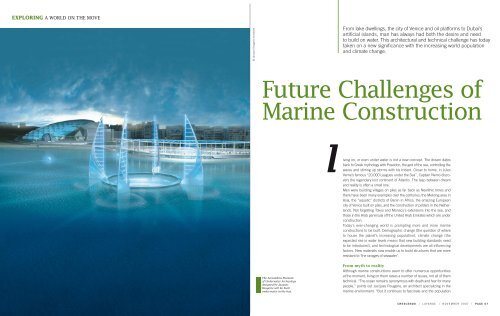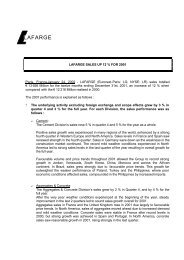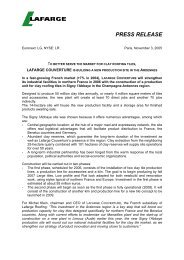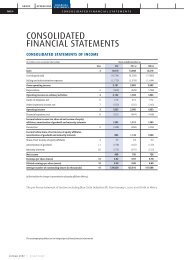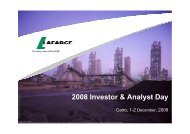The magazine - Lafarge
The magazine - Lafarge
The magazine - Lafarge
You also want an ePaper? Increase the reach of your titles
YUMPU automatically turns print PDFs into web optimized ePapers that Google loves.
EXPLORING A WORLD ON THE MOVE<br />
P A G E 0 6 | L A FA R G E | O C T O B R E 2 0 0 7 | C R E S C E N D O<br />
© Jacques Rougerie architecte<br />
From lake dwellings, the city of Venice and oil platforms to Dubai’s<br />
artificial islands, man has always had both the desire and need<br />
to build on water. This architectural and technical challenge has today<br />
taken on a new significance with the increasing world population<br />
and climate change.<br />
Future Challenges of<br />
Marine Construction<br />
<strong>The</strong> Alexandria Museum<br />
of Underwater Archeology<br />
designed by Jacques<br />
Rougerie will be built<br />
underwater in the bay.<br />
l<br />
iving on, or even under water is not a new concept. <strong>The</strong> dream dates<br />
back to Greek mythology with Poseidon, the god of the sea, controlling the<br />
waves and stirring up storms with his trident. Closer to home, in Jules<br />
Verne’s famous “20,000 Leagues under the Sea”, Captain Nemo discovers<br />
the legendary lost continent of Atlantis. <strong>The</strong> leap between dream<br />
and reality is often a small one.<br />
Men were building villages on piles as far back as Neolithic times and<br />
there have been many examples over the centuries: the Mekong area in<br />
Asia, the “aquatic” districts of Benin in Africa, the amazing European<br />
city of Venice built on piles, and the construction of polders in the Netherlands.<br />
Not forgetting Tokyo and Monaco's extensions into the sea, and<br />
those in the Arab peninsula off the United Arab Emirates which are under<br />
construction.<br />
Today's ever-changing world is prompting more and more marine<br />
constructions to be built. Demographic change (the question of where<br />
to house the planet’s increasing population), climate change (the<br />
expected rise in water levels means that new building standards need<br />
to be introduced), and technological developments are all influencing<br />
factors. New materials now enable us to build structures that are more<br />
resistant to "the ravages of seawater".<br />
From myth to reality<br />
Although marine constructions seem to offer numerous opportunities<br />
at the moment, living on them raises a number of issues, not all of them<br />
technical. “<strong>The</strong> ocean remains synonymous with death and fear for many<br />
people,” points out Jacques Rougerie, an architect specializing in the<br />
marine environment. “But it continues to fascinate and the population<br />
C R E S C E N D O | L A FA R G E | N O V E M B E R 2 0 0 7 | P A G E 0 7


